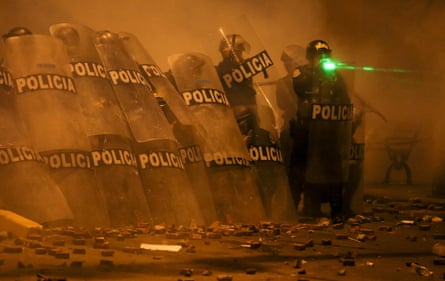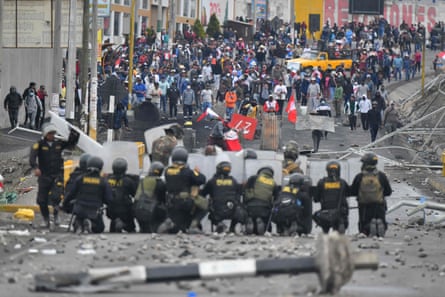A march billed as the “takeover of Lima” escalated into running battles between protesters and riot police amid stone-throwing and swirls of teargas on Thursday evening in Peru’s capital.
Thousands of protesters from across the country poured into Lima earlier in the week to take part in a massive march demanding the resignation of President Dina Boluarte after nearly six weeks of turmoil that has killed more than 50 people, including one police officer and eight people who died as a result of strikes and blockades.
In a late-night television address, Boluarte said police had the protests under control and that those responsible for violence and vandalism would not go “unpunished”, adding “this is not a peaceful march”. She said the “government is firm and its cabinet is more united than ever”.
Boluarte claimed that the protests had “no social agenda” but rather sought to “break the rule of law, generate chaos and disorder and seize power”. She added that attacks on three regional airports had been planned in advance and would be punished with “all the rigour of the law”.
“To the Peruvian people, to those who want to work in peace and to those who generate acts of protest I say: I will not get tired of calling them to a good dialogue, to tell them that we work for the country,” she said.
One person died and about 10 were injured in clashes with police in the southern city of Arequipa on Thursday, according to Peru’s ombudsman’s office, when protesters reportedly tried to invade the airport. Several airports have been closed and huge swathes of the country have been paralysed by more than 120 roadblocks.

Outrage over the rising death toll has powered the mounting protests, which began in early December in support of ousted former president Pedro Castillo but have shifted overwhelmingly to demand Boluarte’s resignation, the closure of Congress and fresh elections. Boluarte was Castillo’s vice-president and replaced him after he attempted to shutter Congress and rule by decree on 7 December.
Earlier on Thursday, thousands marched around Lima’s San Martín square, many holding banners of their place of origin. Peasant security organisations known as ronderos carried traditional whips and Indigenous women wore traditional colourful skirts. There were chants of “Dina, murderer, the people repudiate you” amid banners showing Peru’s first female president bathed in blood.
“We want justice, we don’t want our dead to be forgotten,” Zulema Chacón told the Guardian. “We want that usurper out, she doesn’t represent us.”
“They are the thieves and they lie and lie to us,” said Delia Zevallos, 52, a shopkeeper, referring to the lawmakers in Congress, Peru’s most despised political organ. “The people have woken up, we’re not children any more, we know how to read and write … and no one can tell us what to do.”
Boluarte, who said last week that she would not resign, met a representative of the Office of the UN High Commissioner for Human Rights earlier on Thursday. Last week, the UN agency said it was “very concerned about the rising violence” in Peru.

Both the US and UK ambassadors to Peru welcomed the meeting and issued statements on Thursday calling for calm and exhorting the government to seek dialogue.
In a statement in Spanish on Twitter, the US ambassador, Lisa Kenna, said it was “fundamental that the forces of order respect human rights and protect the citizenry”.
In a similar statement, her UK counterpart, Gavin Cook, called for “immediate and impartial investigations, accountability measures and justice for the victims of the reports of human rights violations”.

 1 year ago
130
1 year ago
130










 English (US)
English (US)